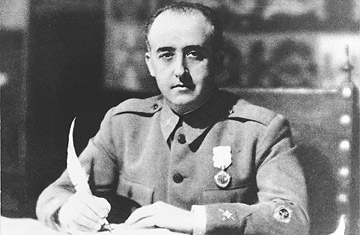
The Franco family has refused to open his Galician house to the public
Two weddings took place at the Pazo de Meirás in northwestern Spain on Friday. In one, held in the chapel of the faux-medieval palace, the real Leticia Giménez-Arnau, great-granddaughter of Spanish dictator Francisco Franco, married her Salvadoran boyfriend in what was no doubt an appropriately austere ceremony. In the other, considerably more rambunctious celebration, an actress playing Leticia arrived at the wedding scene in a convertible driven by a Moorish guard (complete with requisite fez). Greeted with fascist salutes and the extravagant leering of a pompous archbishop, the lovely bride was given away by the familiarly paunchy figure of the caudillo himself, "resurrected" for the occasion by a local comedic theater troupe.
Both the real and mock weddings had symbolic meaning beyond that which normally accompanies the ritual of matrimony. For the 400 people who gathered outside the palace's walls, the farcical ceremony was a protest against the Franco family's private ownership of a historic home that should, in their opinion, belong to the people. Partially sharing that opinion is the government of Galicia, which recently initiated proceedings to have the pazo declared part of the region's cultural patrimony. And thus for the Franco family members, the real wedding, coming as it did in the midst of these legal wranglings, was an opportunity to assert their claim to a home they see as theirs, and theirs alone.
That claim goes all the way back to 1938, when, with the Spanish Civil War still under way, authorities in the region organized a collection to buy the palace and give it to Spain's new dictator. Ever since, Franco and his descendants have used the sprawling compound, with its three reconstructed towers — Napoleon's troops burned the originals — and six hectares of gardens, as a vacation home. More than three decades after her father's death, Carmen, Franco's sole child, continues to summer there every year.
But in a country where nary a statue of the dictator is left standing, and plans are in motion to turn the Valley of the Fallen, Franco's oversized and overwrought mausoleum, into a history museum, it comes as little surprise that some Spaniards take issue with his descendants' continuing claim to a lavish "gift" whose origins, critics say, are suspect. "The dictatorship's propaganda lied for 40 years, saying that the pazo was paid for by popular subscription as a gift for Franco," said Manuel Monge, spokesman of the La Coruãa–based Commission for the Recuperation of Historic Memory, which organized Friday's protest. "But they bought it through extortion, by imposing a revolutionary tax on Galician citizens." The Commission has filed a legal complaint, asking that the property be returned to "its rightful owners, the people."
Although the regional government of Galicia has adopted a more measured stance, it too has decided that the Franco family has to share. The pazo, after all, once belonged to Emilia Pardo Bazán, a noted writer. That heritage, coupled with the compound's distinct architecture, has convinced officials that the property should be protected as part of the region's cultural patrimony. Last summer, the government sent a team of technicians to the palace to inspect its condition and its contents. When the family refused them entry, the government sued for access. In March, the regional supreme court ruled in its favor, and a month later, the technicians were back again. This time, they were admitted.
On Aug. 1, the government moved to have the pazo officially declared a "property of cultural interest," a category that carries protective status. Carmen, Leticia and the rest of Franco's descendants have a month to file an appeal, but the government is confident that it will prevail by the end of the year. "As much for its uniqueness as for its cultural and symbolic significance, the pazo has all the characteristics necessary to obtain the maximum degree of protection," said the councilwoman in charge of cultural heritage, Anxela Bugallo. Once the compound is awarded protected status, the Francos will have to request government permission to make any changes to the property and will be forced to open the home to the public at least four days a month.
Friday's wedding, then, represented one last chance to keep out the rabble. The real Leticia arrived days before the wedding to avoid the paparazzi, and the groom showed up in a car with tinted glass. The 300 or so guests were quickly ushered through tight security. Outside, at the mock celebration, participants feasted on empanadas, potato omelets and boiled octopus. The menu for the real banquet inside, it is safe to speculate, was decidedly more exclusive.
